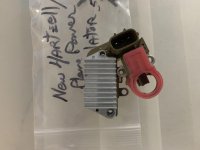Unscientifically and with no real evidence, I believe that an external regulator has greater longevity due to living in a cooler place (electronics don't like heat). Take that for what it is, one man's opinion. Auto alternators have been internally regulated for several decades and they seem to pretty easilly get 100K miles of service, with many going to 150K, so noting really wrong with IR when properly executed. These figures are for the actual OEM versions. Get a cheap overhaul with off shore regulators and the numbers are very different.
IF you do some searching here, it seems there are WELL more than a handful of folks that have seen their PP alternators go south in a relatively short period of time (100-300 hours), some have even bought 2 or 3 of them before 500 hours. Never seem to hear that with the B&C versions. Cheap auto versions also have very few reports of early failures. Mine has 1000 hours now of trouble free service. Given what I have observed on this site, I would NOT buy a PP alt.
The above is true based on history and what you will find here.
I have said this before and will say it again.
1. I have Plane Power and I have B&C alternators.
2. The "original" Plane Power has been purchased by Hartzell.
3. Hartzell is/has been reengineering the PP alternator that they now own.
4. It is **MY OPINION**, based on info that they have shared, that Hartzell will apply the same level of engineering quality to this alternator as they do their props. (I think that most of us trust the engineering of their props and are grateful for their support of our community.)
I share this to point out that as a person with product from "both sides of the fence", I would not, at this point in time write off Plane Power as " ... this is not your father's Plane Power alternator...". (The older ones of us who have followed automobile ads will get the reference here.

Having said all of this, one of the MAIN causes of failure of the PP alternators has been heat causing the "electronics" to fail. (Yes, there were other areas that needed to and have been changed/reengineered.)
A remotely mounted, external regulator (like B&C) increases the reliability significantly. It is an important factor, though not the only factor to influence the length of service.
In case you are wondering, no, I am not being paid to said this, although I HAVE had serious conversations with their management and know how hard they are working to make the products "right".





